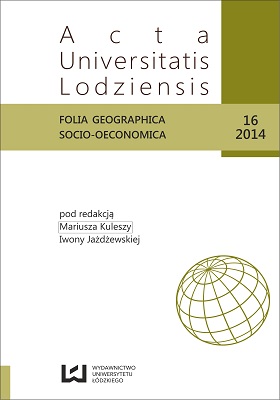East European countryside in transition - case study of Serbia
DOI:
https://doi.org/10.18778/1508-1117.16.15Keywords:
rural development and landscape, restoration and revitalization of the village, cultural heritage, historical colonization of the landscapeAbstract
Modern Serbian village, in the form of bulk or dense settlements, its architecture, constructive materials, spatial layout, functions and ways of exploitation of the soil, vary to some extent in some parts of the country. Natural conditions, time of occurrence, type of farm (if still there), and social structure ‒ all these factors affect rural development and landscape change. All changes in the way of cultivation and function of villages affected the development of construction zones, which were redesigned and rebuilt over many years ‒ not always to the benefit of cultural heritage. The evidence that urbanization can be seen in the Serbian countryside (as in other European countries) are considered in this work, with necessary illustrations. In the process of continuous change, attention should focus on preserving the identity of places and forms of developmental events. Initiated projects are focused on development and reconstruction of infrastructure and preservation of cultural heritage. Awareness of cultural values of Serbian villages and landscapes as subjects of a kind of historical colonization has been shaped during long-term transformation.
References
Beyerlin U., 1997, Dezentrale grenzüberschreitente Zusamenarbeit als internationales Rechtsphenomen, „Archiv des Völkerrechts”, 27(3).
Google Scholar
Dorfenentwicklung. Das Luftbild als Planungshilfe, 1984, Ministry für Ernährung, Landwirtschaft, Umwelt und Forsten Baden-Württemberg.
Google Scholar
Findrik R., 1994, Narodno neimarstvo ‒ Stanovanje, Sirogojno.
Google Scholar
Findrik R., 1998, Dinarska brvnara, Sirogojno.
Google Scholar
Findrik R., 1999, Vajat – znamenje mladosti, Sirogojno.
Google Scholar
Fürst D., Ritter E.H., 1993, Landesentwicklungsplanung und Regionalplanung. Ein Grundriss Verwaltungswissenschaftlicher, Düsseldorf.
Google Scholar
Goppel K., 1991, Raumordnung und Recht, „Raumforschung und Raumordnung”, 2‒3, Berlin.
Google Scholar
DOI: https://doi.org/10.14512/rur.1807
Haindl E., Landzettel W., 1991, Heimat ‒ ein Ort irgendwo?, Mensch, Dorf, Landschaft.
Google Scholar
Hubler K.H., Kaether J., 1999, Nachhaltige Raum und Regisnalentwicklung ‒ bleibt wo sie?, Befunde, Perspektiven und Vorschläge, Wissenschaft und Forschung, Berlin.
Google Scholar
Malchus V. Frh., 1991, Perspektiven für die Regionen an den EG-Binnengrenzen, „Raumforschung und Raumordnung”, Berlin, Materialien zur Ländlichen Neuordnung ‒ Heft 28th Bayerisches Staatsministerium für Ernährung, Landwirtschaft und Forsten, München.
Google Scholar
Shaping New Europe, 2000, Strategic Targets for 2000‒2005 ‒ European Commission Information for the European Parliament, Council UE, Economical and Social Committee and Committee of the Regions.
Google Scholar
Downloads
Published
How to Cite
Issue
Section
License

This work is licensed under a Creative Commons Attribution-NonCommercial-NoDerivatives 4.0 International License.








